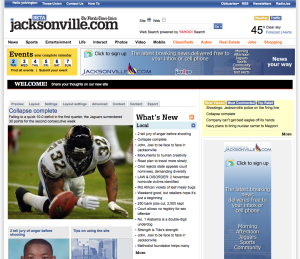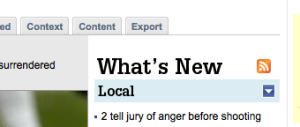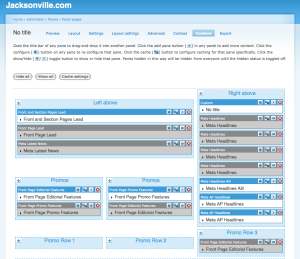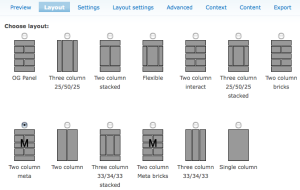I've previously mentioned some of the assumptions and assertions behind the site management toolkit we're developing at Morris. One key assumption is that editors should be able to determine page layouts -- something that's just not possible with a lot of template-driven content management systems. Here's how we're making that work.
Editors begin by seeing the site pretty much as everyone else would.

But if you look closely -- and if you have the permissions that comes with an editor's role -- you see a series of tabs across the top of the main content area on the homepage.

When you click on the content tab, you get a layout dummy. This is accomplished using the Drupal contributed Panels module, written by Earl Miles.

Elements can be added, temporarily disabled (notice the ones that are darkened), dragged and dropped from cell to cell, and so forth. This makes it possible to easily relocate or replace components.
But it's not something that you should have to do in order to update and maintain a site throughout the workday. The actual components displayed on the page are dynamic blocks. Their are determined by applying business rules to the underlying data (stories, images, blog posts, etc.)
For example, one block might list half a dozen of the most recent AP national news stories, while another might feature a picture and headline from the story currently top-ranked by editors. When fresh content is available, the site can automatically change without human intervention.
These blocks are all defined and generated using another Drupal contributed module, Views. It's also written by Earl Miles, recently honored as Drupal MVP. Web producers can learn Views, but it's not something I'd want to have to teach to the copy desk.
A lot of the work that's been going on in Jacksonville over the last month or so has been the development of a library of these Views components and corresponding HTML template work to tailor their output.
This combination of Views, Blocks and Panels is used to manage not only the home page, but also major section fronts such as Sports, News and Interact.
But editors -- not Web geeks, but journalists -- also can create such pages from scratch. It's a straightforward process. You start out by selecting a layout grid from a library.

If you don't like any of the choices, you can also create a custom layout by specifying the number of rows, then the number of columns in each row, and the widths (in pixels or percentages). It's just a matter of filling out a form and no HTML is required.
The resulting grid then can be populated with blocks from the library, or arbitrary content blocks. If you create arbitrary content blocks, you're beginning to get into a requirement that you understand some HTML, but you're still insulated from the complexity of the complete page.
The page is automatically wrapped in the site's standard design, including the required advertising positions, navigation, and branding.
This makes it possible to quickly create topics pages or special presentations for complex major news stories.
Existing pages can be copied, reworked in a "private" mode until they're finished, and then swapped into the live positions. This makes it possible to have a really special homepage when it's time to publish a really special project.
I'll have some more detail on these tools in coming days.

Comments
Impressive flexibility. My
Web accessibilty and SEO
More tomorrow